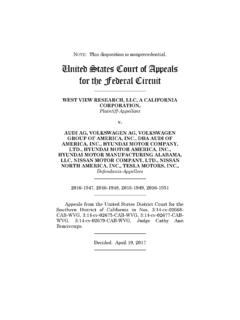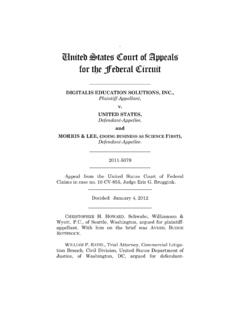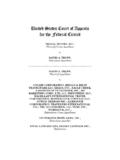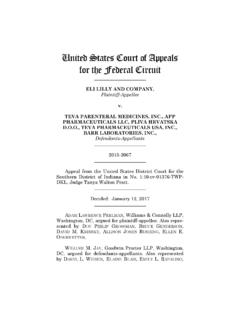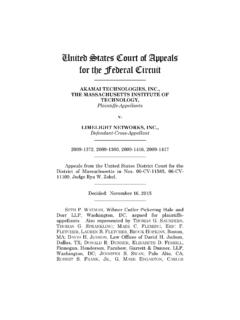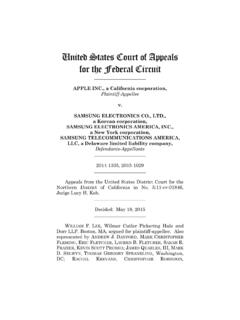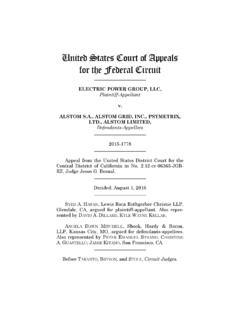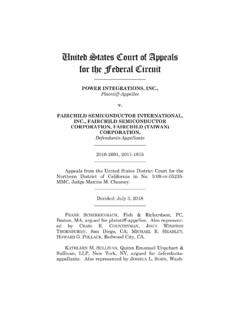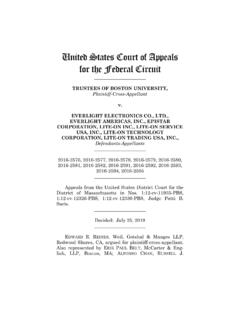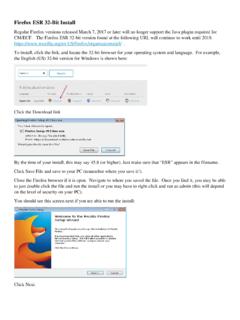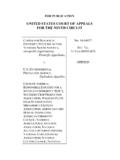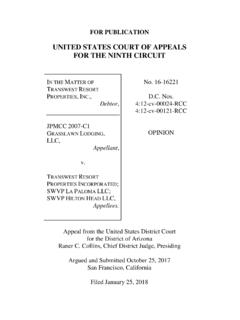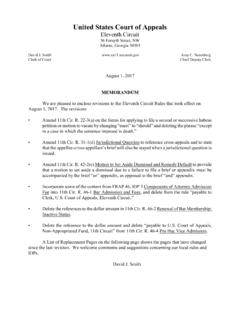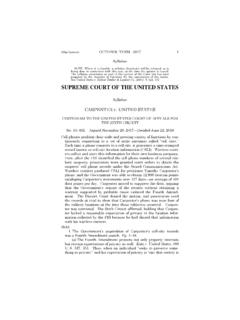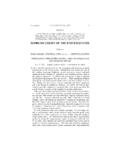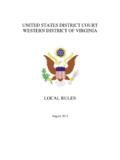Transcription of United States Court of Appeals for the Federal Circuit
1 United States Court of Appeals for the Federal Circuit _____ XITRONIX CORPORATION, Plaintiff-Appellant v. KLA-TENCOR CORPORATION, DBA KLA-TENCOR, INC., A DELAWARE CORPORATION, Defendant-Appellee _____ 2016-2746 _____ appeal from the United States District Court for the Western District of Texas in No. 1:14-cv-01113-SS, Judge Sam Sparks. _____ MICHAEL S. TRUESDALE, Law Office of Michael S. Truesdale, PLLC, Austin, TX, argued for plaintiff-appellant. AARON GABRIEL FOUNTAIN, DLA Piper US LLP, Austin, TX, argued for defendant-appellee. Also repre-sented by BRIAN K. ERICKSON, JOHN GUARAGNA. _____ Before MOORE, MAYER, and HUGHES, Circuit Judges. MOORE, Circuit Judge. XITRONIX CORP. v. KLA-TENCOR CORP. 2 O R D E R The only asserted claim in the underlying case is a Walker Process monopolization claim based on alleged fraud on the United States Patent and Trademark Office ( PTO ).
2 Both parties assert that the Federal Circuit has appellate jurisdiction over this case. We disagree. We therefore transfer the case to the United States Court of Appeals for the Fifth Circuit , which has appellate juris-diction over cases from the District Court for the Western District of Texas. BACKGROUND This appeal arises from a single cause of action filed in the United States District Court for the Western Dis-trict of Texas: a Walker Process monopolization claim under 2 of the Sherman Act and 4 and 6 of the Clay-ton Act based on the alleged fraudulent prosecution of a 29, 63. Xitronix stated the Federal Circuit had jurisdiction over this appeal pursuant to 28 1295(a)(1) and Nobelpharma AB v. Implant Innovations, Inc., 141 1059, 1067 68 (Fed. Cir. 1998), and KLA-Tencor ( KLA ) did not dispute this assertion.
3 Before oral argument, we asked the parties to show cause why we should not transfer this case to the United States Court of Appeals for the Fifth Circuit for lack of jurisdiction. The parties filed supplemental briefs, assert-ing that the Federal Circuit has appellate jurisdiction over this case. The briefs did not address the impact of the Supreme Court s decision in Gunn v. Minton, 568 1 In Walker Process Equipment, Inc. v. Food Ma-chinery & Chemical Corp., the Supreme Court held that enforcement of a patent procured by fraud on the PTO may be a Federal antitrust violation under the Sherman Act, provided all other elements necessary to such a claim are present. 382 172, 176 77 (1965). XITRONIX CORP. v. KLA-TENCOR CORP. 3 251 (2013). At oral argument, we ordered another round of supplemental briefing to address jurisdiction and, in particular, Gunn v.
4 Minton. DISCUSSION This Court has jurisdiction over the appeal of a final decision of a district Court in any civil action arising under .. any Act of Congress relating to patents or plant variety protection. 28 1295(a)(1). Interpreting nearly identical language in a previous version of our jurisdictional statute, the Supreme Court stated our jurisdiction extends only to those cases in which a well-pleaded complaint establishes either that Federal patent law creates the cause of action or that the plaintiff s right to relief necessarily depends on resolution of a substantial question of Federal patent law, in that patent law is a necessary element of one of the well-pleaded claims. Christianson v. Colt Indus. Operating Corp., 486 800, 809 (1988) (emphasis added); see also Holmes Grp.
5 , Inc. v. Vornado Air Circulation Sys., Inc., 535 826, 834 (2002) (By using arising under in our jurisdictional statute, Congress referred to a well-established body of law that requires courts to consider whether a patent-law claim appears on the face of the plaintiff s well-pleaded complaint. ), superseded in part by statute, Leahy-Smith America Invents Act 19(b), Pub. L. No. 112-29, 125 Stat. 284 (2011) ( amending 28 1295(a)(1) to add com-pulsory patent counterclaims). In holding that our jurisdiction extends to cases in which patent law is a necessary element of one of the well-pleaded claims, the Supreme Court explained that the well-pleaded complaint rule focuses on claims, not theories, .. and just because an element that is essential to a particular theory might be governed by Federal patent law does not mean that the entire monopolization claim arises under patent law.
6 Christianson, 486 at 811. In that case, the Court held that the Federal Circuit did XITRONIX CORP. v. KLA-TENCOR CORP. 4 not have jurisdiction over the asserted monopolization claim because it was based on several alleged theories, and only in one of those theories was the patent-law issue [] even arguably essential. Id. More recently, in Gunn, the Supreme Court held that a state law claim alleging legal malpractice in the han-dling of a patent case does not aris[e] under Federal patent law for purposes of exclusive Federal jurisdiction under 28 1 338(a). 568 at 258. Like the language of our jurisdictional statute, 1338(a) States that Federal district courts shall have original jurisdic-tion of any civil action arising under any Act of Congress relating to patents, plant variety protection, copyrights and trademarks.
7 28 1338(a); compare 1338(a), with 1295(a) ( [T]he Federal Circuit shall have exclusive jurisdiction .. of an appeal from a final decision of a district Court .. in any civil action arising under .. any Act of Congress relating to patents or plant variety pro-tection. ) . The state malpractice claim necessarily re-quired application of patent law, creating a patent law case within a case, and the patent issue was actually disputed by the parties. Gunn, 568 at 259. However, the Supreme Court held that the Federal issue in this case is not substantial when analyzed with respect to the Federal system as a whole. Id. at 260. The resolution of the patent case within a case would have no effect on the real-world result of the prior Federal patent litiga-tion, and allowing the state Court to resolve the underly-ing patent issue would not undermine the uniform body of patent law because Federal courts are of course not bound by state Court case-within-a-case patent rulings.
8 Id. at 261 62. Even if a novel question of patent law arose in such a situation, it would still at some point be decided by a Federal Court in the context of an actual patent case, with review in the Federal Circuit , and even if the state Court s adjudication was preclusive under some circum-stances, the result would be limited to the parties and XITRONIX CORP. v. KLA-TENCOR CORP. 5 patents that had been before the state Court . Id. at 262 63. The Supreme Court explained, the possibility that a state Court will incorrectly resolve a state claim is not, by itself, enough to trigger the Federal courts exclusive patent jurisdiction, even if the potential error finds its root in a misunderstanding of patent law. Id. at 263. The complaint in this case alleges that KLA engaged in exclusionary conduct by fraudulently prosecuting to issuance the [ ]260 patent and its conduct was and is specifically intended to monopolize and destroy competi-tion in the market.
9 63. It alleges KLA intentionally made false representations to the PTO on which the examiner relied during prosecution. On the face of the complaint, no allegation establishes that Federal patent law creates the cause of action. Christianson, 486 at 809. The only question is whether the monopolization allegation necessarily depends on resolution of a sub-stantial question of Federal patent law, in that patent law is a necessary element of one of the well-pleaded claims. Id. Applying the well-pleaded complaint rule, in light of the Supreme Court s guidance and rationale in Gunn, we hold that it does not. There is nothing unique to patent law about allega-tions of false statements. Indeed, in responding to the Court s order to show cause, the parties both cited portions of the complaint that focus on fraud and misrepresenta-tion, not patent law.
10 See, , Xitronix Supp. Br. (Sept. 26, 2017) at 4 5 ( KLA-Tencor affirmatively (and repeat-edly) misrepresented the patentability of the claims it sought, including making false representations about what was taught by the relevant prior art. ); KLA Supp. Br. (Sept. 26, 2017) at 8 9 ( KLA s prosecution and pro-curement of the [ ]260 patent was undertaken in bad faith in order to monopolize the .. market. ). We acknowledge that a determination of the alleged misrepresentations to the PTO will almost certainly require some application of patent law. For instance, the complaint alleges that XITRONIX CORP. v. KLA-TENCOR CORP. 6 KLA s attorney failed to map a one-to-one relationship between claim 1 of the 260 patent and another patent claim that had previously been held invalid. 42 43. An evaluation of that allegation may require analysis of the claims and specifications and may require application of patent claim construction principles.
